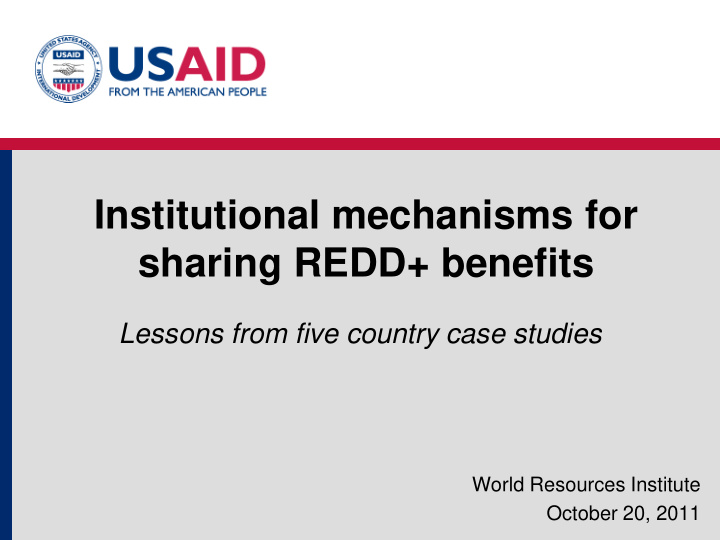



Institutional mechanisms for sharing REDD+ benefits Lessons from five country case studies World Resources Institute October 20, 2011
OBJECTIVE OF THE STUDY Understand how land tenure laws and practices will affect rural communities’ access to REDD+ benefits and provide recommendations
METHODOLOGY • Analysis of the institutional mechanisms being discussed or designed for the distribution of REDD+ benefits • Draws lessons from case studies in 5 countries: Mexico, Tanzania, Indonesia, Democratic Republic of Congo and Nepal – Focus on 1-2 existing institutional mechanisms for distributing benefits from natural resource management to rural communities – Field visits in each country & Literature review
Country case studies Country Institution/project Category of mechanism • Comisión Nacional Forestal (National Mexico Forestry Commission of Mexico Payment for Ecosystem [CONAFOR])’s ProArbol system services (PES) • Carbon PES in Oaxaca Nepal Project-level Forest Carbon Trust Fund Community-Based (FCTF) serving existing community forest Natural Resource management regime Management (CBNRM) • Katingan REDD+ demonstration project • Concession-based Indonesia • Rewards for, Use of and shared model • Mix of PES investment in Pro-poor Environmental Services (RUPES) / RiverCare Project (Conditional tenure) and CBNRM
Country case studies Country Institution/project Category of mechanism • Wildlife Management Area of Enduimet Tanzania • Suledo Forest (Village Land Forest CBNRM Reserve • Ibi-Bateke Clean Development Democratic Republic of Mechanism project Concession-based • Framework for social agreements Congo model between logging companies and local communities
MODEL #1: Payment for Ecosystem Services Examples: Mexico, Indonesia (aspects of the RUPES/RiverCare project) • Common characteristics: – Rights relatively clear and/or recognized – Some level of community organization (“social capital”) – Intermediaries facilitating – Seed funding/investments • Lessons: – Clear and secure tenure is needed for PES to succeed – Clear and secure tenure, and recognition of rights, provides access to opportunities, financial resources and technical capacity – PES benefits are in addition to other co-benefits (e.g. electricity, water protection, etc) – Role of third-party facilitators is key – Links between benefits and improvements in livelihoods (at community and/or individual level) are not always clear or equitable
MODEL #2: Concession-Based Examples: DRC, Indonesia • Common characteristics: – Rights held by concessionaire / project developer, no explicit rights for communities – Community engagement / negotiations facilitated by intermediary institution (usually NGO) – Community access to benefits based on contract (implicit recognition of customary rights) – Concessionaire (or intermediary) has significant control over type and use of benefits, typical focus on promoting sustainable livelihoods • Lessons: – Need for permanent institutions to facilitate dialogue between communities and concession-holder – Investing in community governance vs. reliance on intermediary – Weak links between benefits and performance – Success of project linked to the project developer, need for broader social safeguards.
MODEL #3: Participatory Forest/Wildlife Management Examples: Nepal, Tanzania, Indonesia • Common characteristics: – Breadth and security of property rights, entitlement to revenues defined by law/regulation – Existence of legally recognized community institutions (aggregates) – Community institutions manage revenues and make decisions about distribution. Government may regulate how revenues can be used. • Lessons: – Pros and cons of aggregate institutions: in terms of transaction costs, leakage, corruption risks, accountability to communities – Unclear links to improved livelihoods or poverty reduction – Design and governance of aggregate institutions is important to establish sound governance and allow downward accountability – Support of intermediaries necessary to build capacity of aggregate institutions and communities – Links between benefits and responsibilities /performance not always strong
Recommend
More recommend